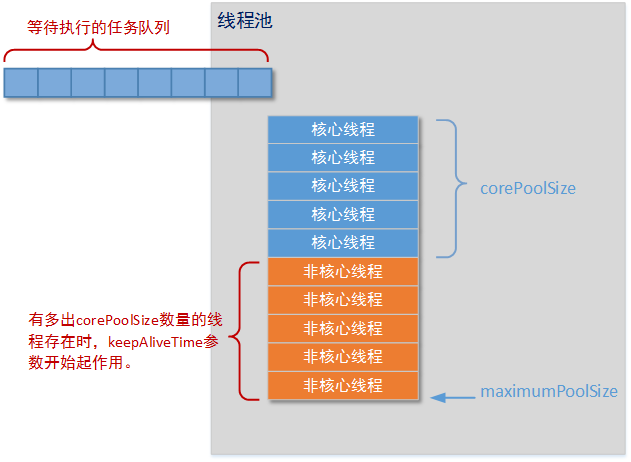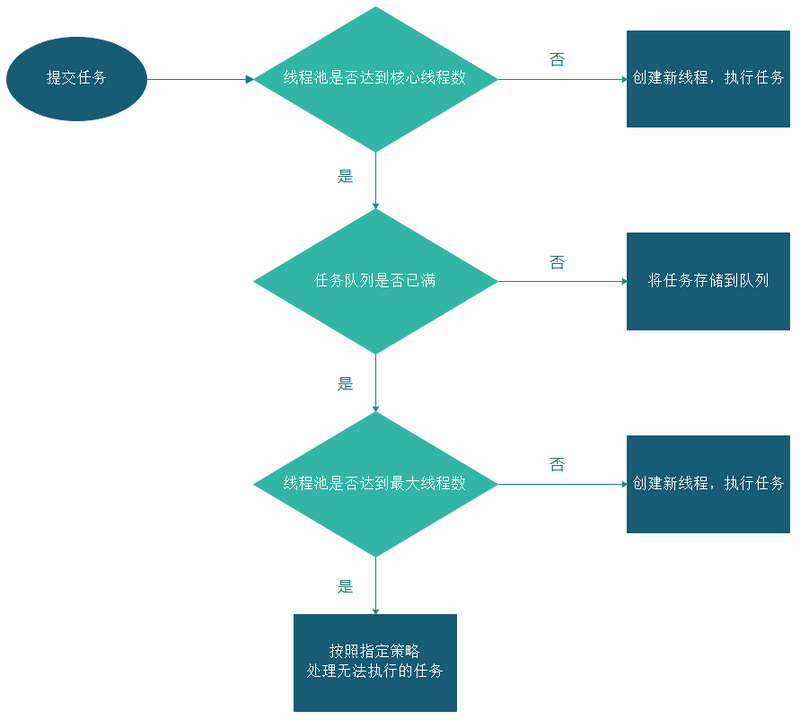ThreadPoolExecutor
ThreadPoolExecutor是Executor框架最重要的一个类,它即是真正意义上的线程池。该类的源码有两千多行,但大部分是注释说明,而且还有一些private/protected的方法,真正会用到的方法也并不太多。
先了解一下它的构造器。
ThreadPoolExecutor的构造器
ThreadPoolExecutor的构造器有4个重载的构造器,其中有两个ThreadFactory和RejectedExecutionHandler类型的参数是可选的。最完整的构造器如下:
1 | /** |
构造器的各个参数说明:
corePoolSize:核心线程数,核心线程会一直存活,即使没有任务需要处理。但如果设置了
allowCoreThreadTimeOut为 true 则核心线程也会超时退出。maximumPoolSize:最大线程数,线程池中可允许创建的最大线程数。
keepAliveTime:当线程池中的线程数大于核心线程数,那些多余的线程空闲时间达到keepAliveTime后就会退出,直到线程数量等于corePoolSize。如果设置了
allowCoreThreadTimeout设置为true,则所有线程均会退出直到线程数量为0。unit:keepAliveTime参数的时间单位
workQueue:在任务执行前用来保存任务的阻塞队列。这个队列只会保存通过execute方法提交到线程池的Runnable任务。在ThreadPoolExecutor线程池的API文档中,一共推荐了三种等待队列,它们是:SynchronousQueue、LinkedBlockingQueue 和 ArrayBlockingQueue。
threadFactory:线程池创建新线程时使用的factory。默认使用defaultThreadFactory创建线程。
handle:饱和策略。当线程池的线程数已达到最大,并且任务队列已满时来处理被拒绝任务的策略。默认使用ThreadPoolExecutor.AbortPolicy,任务被拒绝时将抛出RejectExecutorException
除此之外,ThreadPoolExecutor还有两个个常用的参数设置:
- allowCoreThreadTimeout:是否允许核心线程空闲退出,默认值为false。
- queueCapacity:任务队列的容量。
ThreadPoolExecutor线程池的逻辑结构图:
线程池执行任务的行为方式
线程池按以下行为执行任务
1. 当线程数小于核心线程数时,创建线程。
2. 当线程数大于等于核心线程数,且任务队列未满时,将任务放入任务队列。
3. 当线程数大于等于核心线程数,且任务队列已满
1. 若线程数小于最大线程数,创建线程
2. 若线程数等于最大线程数,抛出异常,拒绝任务

Executors
Executors类是一个工厂类,提供了一系列静态工厂方法来创建不同的ExecutorService或 ScheduledExecutorService实例。
创建3种不同的ExecutorService(线程池)实例
1.newSingleThreadExecutor
创建一个单线程的线程池:启动一个线程负责按顺序执行任务,先提交的任务先执行。
其原理是:任务会被提交到一个队列里,启动的那个线程会从队里里取任务,然后执行,执行完,再从队列里取下一个任务,再执行。如果该线程执行一个任务失败,并导致线程结束,系统会创建一个新的线程去执行队列里后续的任务,不会因为前面的任务有异常导致后面无辜的任务无法执行。
源码:1
2
3
4
5
6public static ExecutorService newSingleThreadExecutor() {
return new FinalizableDelegatedExecutorService
(new ThreadPoolExecutor(1, 1,
0L, TimeUnit.MILLISECONDS,
new LinkedBlockingQueue<Runnable>()));
}
2.newFixedThreadPool
创建一个可重用的固定线程数量的线程池。即corePoolSize=线程池中的线程数= maximumPoolSize。
- 如果没有任务执行,所有的线程都将等待。
- 如果线程池中的所有线程都处于活动状态,此时再提交任务就在队列中等待,直到有可用线程。
- 如果线程池中的某个线程由于异常而结束时,线程池就会再补充一条新线程。
源码:1
2
3
4
5public static ExecutorService newFixedThreadPool(int nThreads) {
return new ThreadPoolExecutor(nThreads, nThreads,
0L, TimeUnit.MILLISECONDS,
new LinkedBlockingQueue<Runnable>());
}
3.newCachedThreadPool
创建一个不限制线程数量的动态线程池。
- 因为有多个线程存在,任务不一定会按照顺序执行。
- 一个线程完成任务后,空闲时间达到60秒则会被结束。
- 在执行新的任务时,当线程池中有之前创建的空闲线程就使用这个线程,否则就新建一条线程。
源码:1
2
3
4
5public static ExecutorService newCachedThreadPool() {
return new ThreadPoolExecutor(0, Integer.MAX_VALUE,
60L, TimeUnit.SECONDS,
new SynchronousQueue<Runnable>());
}
可以看到newCachedThreadPool使用的队列是SynchronousQueue,和前两个是不一样的。线程池的线程数可达到Integer.MAX_VALUE,即2147483647。此外由于会有线程的创建和销毁,所以会有一定的系统开销。
4.newSingleThreadExecutor 与 newFixedThreadPool(1) 的区别
JavaDoc上说:
Unlike the otherwise equivalent newFixedThreadPool(1) the returned executor is guaranteed not to be reconfigurable to use additional threads.
举个例子:
((ThreadPoolExecutor)newFixedThreadPool(1)).setCorePoolSize(3);
即newFixedThreadPool(1)可以后期修改线程数,不保证线程只有一个。而newSingleThreadExecutor可以保证。
创建ScheduledExecutorService实例
关于ScheduledExecutorService的内容,在下一篇文章中介绍。
1.newSingleThreadScheduledExecutor
创建一个单线程的ScheduledExecutorService,在指定延时之后执行或者以固定的频率周期性的执行提交的任务。在线程池关闭之前如果有一个任务执行失败,并导致线程结束,系统会创建一个新的线程接着执行队列里的任务。
源码:1
2
3
4public static ScheduledExecutorService newSingleThreadScheduledExecutor() {
return new DelegatedScheduledExecutorService
(new ScheduledThreadPoolExecutor(1)); //corePoolSize为1
}
还有一个重载的方法,多了一个ThreadFactory参数,ThreadFactory是用来确定新线程应该怎么创建的。1
2
3
4public static ScheduledExecutorService newSingleThreadScheduledExecutor(ThreadFactory threadFactory) {
return new DelegatedScheduledExecutorService
(new ScheduledThreadPoolExecutor(1, threadFactory));
}
2.newScheduledThreadPool
创建一个固定线程数的ScheduledExecutorService对象,在指定延时之后执行或者以固定的频率周期性的执行提交的任务。
1 | public static ScheduledExecutorService newScheduledThreadPool(int corePoolSize) { |
同样的,也有一个重载的方法:1
2
3
4public static ScheduledExecutorService newScheduledThreadPool(
int corePoolSize, ThreadFactory threadFactory) {
return new ScheduledThreadPoolExecutor(corePoolSize, threadFactory);
}